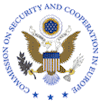 3/19/2013 -- United States Helsinki Commission holds Hearing entitled, "The Trajectory of Democracy – Why Hungary Matters" to "examine Hungary’s constitutional changes with a particular view to the independence of the judiciary, present-day Hungary’s relationship to its Holocaust-era past, and the implications of Hungary’s sweeping legal changes for civil society, including an independent media and religious organizations." AMERICAN HUNGARIAN FEDERATION TESTIMONY ENTERED INTO RECORD. [read more] 3/19/2013 -- United States Helsinki Commission holds Hearing entitled, "The Trajectory of Democracy – Why Hungary Matters" to "examine Hungary’s constitutional changes with a particular view to the independence of the judiciary, present-day Hungary’s relationship to its Holocaust-era past, and the implications of Hungary’s sweeping legal changes for civil society, including an independent media and religious organizations." AMERICAN HUNGARIAN FEDERATION TESTIMONY ENTERED INTO RECORD. [read more]
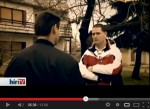  3/19/2013 - Deathtoll rises as Violence against Hungarians continues in Serbia. AHF continues to be deeply concerned with anti-Hungarian attitudes and the lack of progress toward acceptance of diversity and the re-establishment of autonomy for the Vojvodina province. Recent attacks in the early part of 2013 include the severe beating of two teens in Temerin in January, one of whom required surgery to save his eyesight. In February in Szabadka (Subotica), 5 teens were severely attacked, for speaking Hungarian. These violent acts have repeated across the province.
[see this HirTV documentary (in Hungarian)] 3/19/2013 - Deathtoll rises as Violence against Hungarians continues in Serbia. AHF continues to be deeply concerned with anti-Hungarian attitudes and the lack of progress toward acceptance of diversity and the re-establishment of autonomy for the Vojvodina province. Recent attacks in the early part of 2013 include the severe beating of two teens in Temerin in January, one of whom required surgery to save his eyesight. In February in Szabadka (Subotica), 5 teens were severely attacked, for speaking Hungarian. These violent acts have repeated across the province.
[see this HirTV documentary (in Hungarian)]
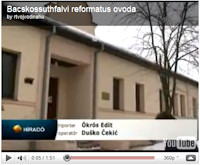 3/7/2011 - The 2011 Washington Hungarian Ball to raise funds for Hungarian nursery school in Bácskossuthfalva: Founded in 2005, this is the only such school officially recognized by Serbian authorities. Despite the official recognition, Serbia has refused to extend any financial support. The school is under serious financial distress and your support is greatly needed and appreciated. See the VIDEO INTERVIEW ( 3/7/2011 - The 2011 Washington Hungarian Ball to raise funds for Hungarian nursery school in Bácskossuthfalva: Founded in 2005, this is the only such school officially recognized by Serbian authorities. Despite the official recognition, Serbia has refused to extend any financial support. The school is under serious financial distress and your support is greatly needed and appreciated. See the VIDEO INTERVIEW ( magyarul). [Read more] about the 2011 Hungarian Ball and support us! magyarul). [Read more] about the 2011 Hungarian Ball and support us!
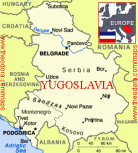 2/29/2008 - As Kosovo gains independence, AHF calls attention to the largest minority in the region: The Hungarians in the former Yugoslavia and within the Carpathian Basin. The recent independence of Kosovo and resulting violence deeply concerns the Federation who calls international attention to the Hungarians of Vojvodina, who lost autonomy by the Serbian totalitarian regime of Milosevic, and those elsewhere in Central Europe. In a Letter to the Editor published in the Washington Times, AHF's Geza Cseri writes: "What is also bothersome and surprising is that there is no overall analysis of minority rights in Central Europe, which is crucial to the peace of the region as well as the whole of Europe. No mention of the rights of one of Europe's largest minorities, the indigenous Hungarian minorities living in Romania, Slovakia and Ukraine. They number more than 4 million." [Read the entire Letter to the Editor] 2/29/2008 - As Kosovo gains independence, AHF calls attention to the largest minority in the region: The Hungarians in the former Yugoslavia and within the Carpathian Basin. The recent independence of Kosovo and resulting violence deeply concerns the Federation who calls international attention to the Hungarians of Vojvodina, who lost autonomy by the Serbian totalitarian regime of Milosevic, and those elsewhere in Central Europe. In a Letter to the Editor published in the Washington Times, AHF's Geza Cseri writes: "What is also bothersome and surprising is that there is no overall analysis of minority rights in Central Europe, which is crucial to the peace of the region as well as the whole of Europe. No mention of the rights of one of Europe's largest minorities, the indigenous Hungarian minorities living in Romania, Slovakia and Ukraine. They number more than 4 million." [Read the entire Letter to the Editor]
 2/21/2008 - AHF monitoring developments in Kosovo and calls for autonomy for historic Hungarian minorities in Vojvodina and elsewhere in the Carpathian Basin. With independence of Kosovo and the potential for additional violence, the Federation is concerned over the lack of international attention to the Hungarian minority in the former Yugoslavia. "While Kosovars and other nations of Central and Eastern Europe have realized their aspirations for self-determination, the Hungarian minorities are still denied the right of autonomy within existing borders." [read more] 2/21/2008 - AHF monitoring developments in Kosovo and calls for autonomy for historic Hungarian minorities in Vojvodina and elsewhere in the Carpathian Basin. With independence of Kosovo and the potential for additional violence, the Federation is concerned over the lack of international attention to the Hungarian minority in the former Yugoslavia. "While Kosovars and other nations of Central and Eastern Europe have realized their aspirations for self-determination, the Hungarian minorities are still denied the right of autonomy within existing borders." [read more]
 7/25/2007
- AHF Calls for protection on minorities in both Kosovo and Vojvodina. With independence of Kosovo inevitable, and the potential for violence, the Federation calls international attention to the other large minority in the former Yugoslavia: The Hungarians of Vojvodina who lost autonomy by Serbian totalitarian regime of Milosevic. AHF publishes Letter to the Editor regarding Kosovo Independence:
"Because intolerance toward minorities characterizes the region,
minority rights guarantees – a prerequisite to democracy and stability
-- must not be entrusted exclusively to the local political elites."
[read more] 7/25/2007
- AHF Calls for protection on minorities in both Kosovo and Vojvodina. With independence of Kosovo inevitable, and the potential for violence, the Federation calls international attention to the other large minority in the former Yugoslavia: The Hungarians of Vojvodina who lost autonomy by Serbian totalitarian regime of Milosevic. AHF publishes Letter to the Editor regarding Kosovo Independence:
"Because intolerance toward minorities characterizes the region,
minority rights guarantees – a prerequisite to democracy and stability
-- must not be entrusted exclusively to the local political elites."
[read more]
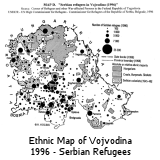 6/13/2006
- Yugoslavia: Then and Now. The Washington Times publishes
AHF letter to the editor. AHF's Frank Koszorus
Jr. writes: "Jeffrey T. Kuhner observes that Yugoslavia is dead ("Yugoslavia,
rest in peace," Commentary, Thursday). Actually, Yugoslavia was stillborn.
Even as it was being cobbled together as part of post-World War I peacemaking,
Croats (and other nationalities) resented Belgrade's domination. Stjepan
Radic of the Croatian Peasant Party was interned for petitioning the peace
conference for Croatian autonomy and later was shot in parliament. Yugoslavia
was part of a far larger drama and tragedy that unfolded in 1920. By creating
an unworkable European order, the peacemakers following "the war
to end all wars" actually laid the groundwork for a greater conflagration
19 years later....." [download
the full article] 6/13/2006
- Yugoslavia: Then and Now. The Washington Times publishes
AHF letter to the editor. AHF's Frank Koszorus
Jr. writes: "Jeffrey T. Kuhner observes that Yugoslavia is dead ("Yugoslavia,
rest in peace," Commentary, Thursday). Actually, Yugoslavia was stillborn.
Even as it was being cobbled together as part of post-World War I peacemaking,
Croats (and other nationalities) resented Belgrade's domination. Stjepan
Radic of the Croatian Peasant Party was interned for petitioning the peace
conference for Croatian autonomy and later was shot in parliament. Yugoslavia
was part of a far larger drama and tragedy that unfolded in 1920. By creating
an unworkable European order, the peacemakers following "the war
to end all wars" actually laid the groundwork for a greater conflagration
19 years later....." [download
the full article]
The good and bad of Yugoslavia, by Tibor Purger. "Jeffrey Kuhner himself is mistaken — not the Macedonian Prime
Minister he quotes — about the Yugoslav idea and on several other
counts (Yugoslavia, rest in peace, Commentary, Friday). First, Yugoslavia
was dead not when Montenegro declared independence this month, but when
Slovenia and Croatia did so 15 years ago after Slobodan Milosevic had
started to recreate Serb domination by force. [download
the article]
 HAND
GRENADE THROWN AT HOME OF SERBIA'S HUNGARIAN MINORITY LEADER. RFE/RFL
Newsline, 8/30/2005 HAND
GRENADE THROWN AT HOME OF SERBIA'S HUNGARIAN MINORITY LEADER. RFE/RFL
Newsline, 8/30/2005
Unknown persons hurled a hand
grenade at the Subotica home of Jozef Kasza, who heads the League of Vojvodina
Hungarians, in the early hours of 30 August, the private Beta news agency
reported. There was slight damage to Kasza's house and the one next door,
but nobody was injured. Police said that the device was a "hand grenade"
and are investigating. Kasza was not immediately willing to make any comment
to the media. He is an outspoken critic of nationalist tendencies in Serbian
politics who told the Organization for Security and Cooperation in Europe
in February that Serbia is "sinking in nationalist euphoria"
(see "RFE/RL Newsline," 15 September 2004 and 17 February 2005,
and "RFE/RL Balkan Report," 18 February 2005). In Belgrade,
Serbian Prime Minister Vojislav Kostunica condemned the incident, calling
it "a crime directed against the Serbian state." He promised
to catch those responsible and to ensure the security of all Serbia's
citizens, including members of national minorities.
VOJVODINA HUNGARIANS
CALL FOR LOCAL AUTONOMY.
RFE/RFL Newsline, 7/14/2005
The League of Vojvodina Hungarians
announced in Szabadka (Subotica) on 13 July a proposed amendment to the
Serbian Constitution that will allow local self-government and a high
degree of autonomy in areas where ethnic minorities constitute the bulk
of the population, RFE/RL's South Slavic and Albanian Languages Service
reported. The Belgrade leadership is a staunch defender of "decentralization"
in Kosova to give the Serbian minority there a high degree of self-rule,
but has been reluctant to extend similar rights to its own minorities.
During the late 17th and into the 18th centuries, the Habsburgs encouraged
Ottoman Serbs and people from throughout Central Europe to settle in what
is now Vojvodina, which Habsburg forces had recently retaken from the
Turks. The region became an ethnic mosaic and remained so through 1945,
but its large German minority was expelled at the end of World War II,
and many of the region's Hungarians fled or were deported at the same
time.
Vojvodina's Serbian population
grew with Belgrade's support in the interwar years and under the communists.
During the rule of former Serbian and Yugoslav President Slobodan Milosevic
from the late 1980s to 2000, many Croats, Hungarians, and other people
of central European origin left Vojvodina, but the area was generally
spared the forced ethnic-cleansing campaigns Belgrade employed elsewhere
in the former Yugoslavia.
 6/10/2005
- "Hungarians
should just dance" - Serbian radicals increasing pressure on Vojvodina
Hungarian political parties. The Federation of Vojvodina Hungarians
held a press conference to discuss efforts at intimidation and fear by
radical Serbian politicians. The Serbs also appointed special prosecutors
to begin bogus investigations of political activities in an assault on
democracy and minority rights. While the violence continues... AHF fears
a new Kosovo. [read full article
in Hungarian] 6/10/2005
- "Hungarians
should just dance" - Serbian radicals increasing pressure on Vojvodina
Hungarian political parties. The Federation of Vojvodina Hungarians
held a press conference to discuss efforts at intimidation and fear by
radical Serbian politicians. The Serbs also appointed special prosecutors
to begin bogus investigations of political activities in an assault on
democracy and minority rights. While the violence continues... AHF fears
a new Kosovo. [read full article
in Hungarian]
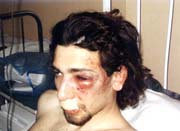 6/1/2005
- The Violence
against Hungarians continues: 6/1/2005
- The Violence
against Hungarians continues:
A Horgos boy was beaten until covered by blood in Subotica,
Magdolna Miskolci, Magyar Szo
Jeno Urban is a young
man from Horgos and is the leader of the Bela Bartok Public Education
Society's break group. However, this young man of great motion skill and
who also teaches children, will not spin on his head for a while. [read
more]
 3/3/2005
- The
President of the Assembly of European Regions, Riccardo Illy, called on
the Serbian government to guarantee the autonomy of Vojvodina. Serbian media
reports that autonomy for Vojvodina was the hot topic during conference
on Regionalism in Novi Sad. Conference participants agreed that financing
and constitutional status were the most important issues for
all European regions, including Vojvodina. 3/3/2005
- The
President of the Assembly of European Regions, Riccardo Illy, called on
the Serbian government to guarantee the autonomy of Vojvodina. Serbian media
reports that autonomy for Vojvodina was the hot topic during conference
on Regionalism in Novi Sad. Conference participants agreed that financing
and constitutional status were the most important issues for
all European regions, including Vojvodina.
The chairman of the Vojvodina
Assembly, Bojan Kostres, described Vojvodina as having been at the same
economic level as Slovenia when it had controlled its own income. “Slovenia is now a member
of the European Union while Vojvodina is where it is. With the return
of autonomy to Vojvodina we would have a chance to develop both Vojvodina
and Serbia,” he said.
[read
more]
 3/3/2005
- US
State Department's Bureau
of Democracy, Human Rights, and Labor Releases Country
Report on Human Rights Practices - 2004: Serbia and Montenegro 3/3/2005
- US
State Department's Bureau
of Democracy, Human Rights, and Labor Releases Country
Report on Human Rights Practices - 2004: Serbia and Montenegro
Excerpts from the
full report:
"After the December
2003 parliamentary elections--in which the SRS took a plurality of seats--there
was an upsurge in vandalism and violence against minority ethnic and religious
groups in the northern Serbian province of Vojvodina.... The targets were
mainly ethnic Hungarians and ethnic Croats--the two largest minorities
in Vojvodina."
The report continues,
"Among the incidents that targeted religious sites or adherents were:
The January 19 desecration of a Hungarian Catholic cemetery in Novi Sad;
the January 19 desecration of a Reformist church in Sombor; the January
24 desecration of a Croatian Catholic cemetery in Subotica; the desecration
of another Subotica graveyard, where Croats and Bunjevci (both Catholic
groups) are buried, on the night of March 26-27; the desecration of 21
gravestones in the Catholic and Orthodox graveyard in Novi Becej between
May 1 and 2; and an attack in Novi Sad on two Christian Adventist ministers.
The number of antiminority
incidents in Serbia's northern province of Vojvodina increased markedly
after the SRS won a plurality of votes in Serbian parliamentary elections
in December 2003. While the incidents consisted mainly of vandalism targeting
cemeteries, homes, churches, and cultural sites, there were also death
threats and assaults (see Section 2.c.). For example, on April 9, Bela
Csorba, Vice President of the Hungarian Democratic Party of Vojvodina,
found a 12-inch kitchen knife wrapped in paper slipped under his door.
Attached to the weapon was a note in Serbian, "we will slaughter
you." On September 28, an ethnic Hungarian high school student was
beaten by a Serb student at whom he smiled on the bus. According to an
eyewitness and the victim, the Serb boy said, "no Hungarian has ever
smiled at me and none will ever do so!" Other boys joined in the
beating, and when friends of the victim tried to help him, they were beaten
as well."
AHF is pleased that the US
State Department is paying attention and hopes to work with officials
to help bring an end to these barbaric events.See the full, official State
Department Report
2/4/2005 - With
President Bush's inaugural speech embracing "self-government"
and "protection of minorities," AHF plans to advance policies
that embrace autonomy and national self-determination for ethnic Hungarian
communities struggling for survival. In a related story, NGO CALLS FOR
ACTION ON KOSOVA'S INDEPENDENCE... The International Crisis Group
(ICG) said in a 40-page report released in Prishtina, Belgrade, and Brussels
on 24 January that "either 2005 will see the start of a final status
solution that consolidates peace and development, or Kosovo may return
to conflict and generate regional instability." AHF is calling for
international attention on the Vojvodina province in Serbia-Montenegro
where anti-Hungarian violence continues as see below. [Read
the ICG Report]
 2/2/2005
- The
Violence continues: Six-member Hungarian family
slain in Vojvodina, Serbia-Montenegro 2/2/2005
- The
Violence continues: Six-member Hungarian family
slain in Vojvodina, Serbia-Montenegro
(AP) Six members
of a Hungarian family were brutally killed in adjoining homes in a northern
Serbian town on the border with Hungary, radio B-92 reported Wednesday.
The bodies were found Tuesday in the family's adjoining homes in the town
of Horgos, after neighbors noticed the houses were unusually quiet. A
local court judge, Snjezana Lekovic, confirmed the killing, but police
gave no official statement on the case. Horgos lies in Serbia's northern
Vojvodina province that has recently seen a rise in attacks against the
region's minority ethnic Hungarians. [read more]
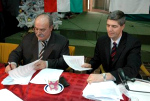 1/11/2005
- The Szabadka Initiative:
AHF signs joint declaration of the Szabadka Initiative by ethnic
Hungarian political parties and human rights organizations from successor
states in an appeal to the Hungarian Government for more coherent support,
coordinated planning, and dual ctizenship. 1/11/2005
- The Szabadka Initiative:
AHF signs joint declaration of the Szabadka Initiative by ethnic
Hungarian political parties and human rights organizations from successor
states in an appeal to the Hungarian Government for more coherent support,
coordinated planning, and dual ctizenship.
Fifteen organizations, including AHF Member CHACR,
from Europe, North America, and Latin America met January 5-6, 2005 in
Szabadka/Subotica (Vajdaság/Vojvodina, Serbia-Montenegro) to join
forces to...[read more]
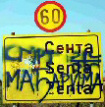 10/30/2004
- AHF
Releases Statement on Vojvodina Violence. Reacts to Anti-Hungarian Grafitti:
“Drop dead Hungarians” 10/30/2004
- AHF
Releases Statement on Vojvodina Violence. Reacts to Anti-Hungarian Grafitti:
“Drop dead Hungarians”
In the last six months, non-Serbs, including members
of Vojvodina’s 300,000-strong Hungarian minority, have been harassed and
assaulted and their cemeteries and churches have been desecrated in a
wave of physical violence, vandalism and anti-Semitism. [read more]
5/13/2004 - Vojvodina
Leader Accuses Belgade Elite of Oppression...The speaker of Vojvodina's
parliament, Nenad Canak, has accused political elites in Belgrade of harassing
pro-European and democratic parties in that province, Deutsche Welle's
"Monitor" reported on 12 May. Canak said the alleged oppression is the
result of a slide toward increasing nationalism in Belgrade. In early
March, members of Serbian Prime Minister Vojislav Kostunica's coalition
slammed an initiative for greater autonomy for Vojvodina as a "direct
attack on the integrity of the Serbian state and the interests of the
[ethnic Serbian] majority population." The so-called Subotica Initiative
as led by Canak, who heads the League of Social Democrats in Vojvodina,
and Jozef Kasza of the League of Vojvodina Hungarians. (see "RFE/RL
Newsline," March 3, 4 April 30)
 4/5/2004 - Hungarians Fear
Renewed Ethnic
Cleansing: Serbs step up intimidation of Hungarians in Vojvodina...Minority
communities in Serbia's former Hungarian northern province of Vojvodina
(Vajdaság) are feeling the heat after recent stunning gains by Serbian
ultra-nationalists raised fears of a return to the ethnic violence of
the 1990s. 4/5/2004 - Hungarians Fear
Renewed Ethnic
Cleansing: Serbs step up intimidation of Hungarians in Vojvodina...Minority
communities in Serbia's former Hungarian northern province of Vojvodina
(Vajdaság) are feeling the heat after recent stunning gains by Serbian
ultra-nationalists raised fears of a return to the ethnic violence of
the 1990s.
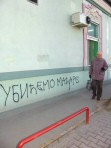 Residents
in the province's capital, Novi Sad (Ujvidek), were woken by drunken mobs
over Serbian New Year on January 13-14 shouting, "Hey Serbs let's
butcher the Croats! Hey Serbs, let's butcher the Hungarians!" In
recent developments, Serbs riot and set historic landmarks on fire and
spray graffiti saying "We Will Kill Hungarians." Residents
in the province's capital, Novi Sad (Ujvidek), were woken by drunken mobs
over Serbian New Year on January 13-14 shouting, "Hey Serbs let's
butcher the Croats! Hey Serbs, let's butcher the Hungarians!" In
recent developments, Serbs riot and set historic landmarks on fire and
spray graffiti saying "We Will Kill Hungarians."
During the recent
bloodshed in Kosovo, violence also broke out in the northern Serb province
of Vojvodina. According to Tanjug News Agency in Belgrade, there
were several dozen protests throughout the province. The region’s
large ethnic Hungarian minority was the target of the attacks especially
in the provincial capital of Novi Sad.
 Duna
TV on March 19 reported a group of demonstrators had “vandalized and smashed
up things and set fire to them.” The mob also attacked the Magyar
Szinhaz (Hungarian Theater), a symbol of Hungarian culture in Vojvodina.
The report states that following a performance, a shouting crowd marched
in front of the theater and broke the doors and windows as well as ripped
off the posters and pictures promoting the show. The Tanjug News
Agency on March 22 reported several injuries during the protest. Duna
TV on March 19 reported a group of demonstrators had “vandalized and smashed
up things and set fire to them.” The mob also attacked the Magyar
Szinhaz (Hungarian Theater), a symbol of Hungarian culture in Vojvodina.
The report states that following a performance, a shouting crowd marched
in front of the theater and broke the doors and windows as well as ripped
off the posters and pictures promoting the show. The Tanjug News
Agency on March 22 reported several injuries during the protest.
According to Radio
B92 in Belgrade, nationalist graffiti was found on a cathedral saying
“Death to Hungarians” in the northern city of Novi Sad (Ujvidek). There
have been many cases of anti-Hungarian graffiti in the city.
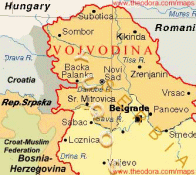 On
Duna TV (March 19), the Alliance of Vojvodina Hungarians (SVM) condemned
the violence and called for the ethnic Hungarians to stay calm.
Peace and stability has returned after the few days of protests.
On Kossuth Radio (March 20), Jozsef Kasza, leader of SVM, “demanded that
the Serbian government prevent the settling of ethnic scores and that
it punish the perpetrators of the law and order offences that had taken
place at the Theater.” Tanjug News Agency stated that criminal charges
have been filed against numerous individuals who participated in the violent
acts in Vojvodina. On
Duna TV (March 19), the Alliance of Vojvodina Hungarians (SVM) condemned
the violence and called for the ethnic Hungarians to stay calm.
Peace and stability has returned after the few days of protests.
On Kossuth Radio (March 20), Jozsef Kasza, leader of SVM, “demanded that
the Serbian government prevent the settling of ethnic scores and that
it punish the perpetrators of the law and order offences that had taken
place at the Theater.” Tanjug News Agency stated that criminal charges
have been filed against numerous individuals who participated in the violent
acts in Vojvodina.
March 2004 brought
more sadness and fear when 85 crosses were pulled out and broken in Subotica
(Szabadka). Another 100 had been destroyed in a previous attack in a different
cemetery in January. The police always come up with some useless "results"
This time they say it was two 7-year-olds who did it.
 Violence
and anti-Hungarian graffiti spread to smaller towns as well: Zenta (35,000,
70% Hungarian) and the neighboring Ada (20,000, 75% Hungarian). See on
the left, Zenta's city sign was vandalized with the words "Death
to Hungarians" on April 4, 2004 [read more] Violence
and anti-Hungarian graffiti spread to smaller towns as well: Zenta (35,000,
70% Hungarian) and the neighboring Ada (20,000, 75% Hungarian). See on
the left, Zenta's city sign was vandalized with the words "Death
to Hungarians" on April 4, 2004 [read more]
[<
back to all AHF news]
|
Shortcuts
Why So Many Hungarians Across the Border?
 Vojvodina (Vajdsaság in Hungarian), an integral part of Hungary for over 1000 years, was awarded to the newly formed Yugoslavia
by the French at the "Treaty" of Trianon in 1920 when Hungary lost 2/3 of her territory and 1/3 of
her Hungarian population. Intimidation, large scale evictions and ethnic cleansing, emigration, and fear of self-reporting have official estimates of only 300-350,000 ethnic Hungarians
remaining in the province. Some, however, estimate this number to be double that
since many fear self-reporting as Hungarian exposes them to risk.The American-Hungarian community
is increasingly concerned by ethnic violence in Vojvodina. Vojvodina (Vajdsaság in Hungarian), an integral part of Hungary for over 1000 years, was awarded to the newly formed Yugoslavia
by the French at the "Treaty" of Trianon in 1920 when Hungary lost 2/3 of her territory and 1/3 of
her Hungarian population. Intimidation, large scale evictions and ethnic cleansing, emigration, and fear of self-reporting have official estimates of only 300-350,000 ethnic Hungarians
remaining in the province. Some, however, estimate this number to be double that
since many fear self-reporting as Hungarian exposes them to risk.The American-Hungarian community
is increasingly concerned by ethnic violence in Vojvodina.
"Ethnic
Cleansing" in action
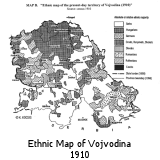 How
did this region become part of Yugoslavia? Read "The Conflict in
the Former Yugoslavia and Autonomous Region of Vojvodina, and the Need
for a More Coherent U.S. Foreign Policy" by Bryan Dawson and refer to the following demographic maps comparing
Vojvodina in 1910 and 1991. Note the decline seen here in Hungarian population
does NOT take into consideration the Balkan conflicts and the significant
escalation of atrocities against Hungarians over the last decade: How
did this region become part of Yugoslavia? Read "The Conflict in
the Former Yugoslavia and Autonomous Region of Vojvodina, and the Need
for a More Coherent U.S. Foreign Policy" by Bryan Dawson and refer to the following demographic maps comparing
Vojvodina in 1910 and 1991. Note the decline seen here in Hungarian population
does NOT take into consideration the Balkan conflicts and the significant
escalation of atrocities against Hungarians over the last decade:
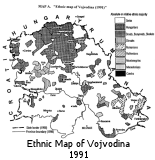 One thousand years of nation building successfully delineated groups based on culture, religion, geography, and other attributes to create the countries with which we are so familiar. While some WesternEuropean nations would continue power struggles and princely battles and civil wars, Hungary, founded in 896, was a peaceful multi-ethnic state for a 1000 years and her borders were virtually unchanged. Until 1920... One thousand years of nation building successfully delineated groups based on culture, religion, geography, and other attributes to create the countries with which we are so familiar. While some WesternEuropean nations would continue power struggles and princely battles and civil wars, Hungary, founded in 896, was a peaceful multi-ethnic state for a 1000 years and her borders were virtually unchanged. Until 1920...
 The Treaty of Trianon in 1920... in the aftermath of WWI, was extremely harsh on Hungary and unjustifiably one-sided. The resulting "treaty" lost Hungary an unprecedented 2/3 of her territory, and 1/2 of her total population or 1/3 of her Hungarian-speaking population. Add to this the loss of up to 90% of vast natural resources, industry, railways, and other infrastructure. The clear winner of the land grab, was Rumania, who, established only 60 years earlier, more than doubled in size overnight. The Treaty of Trianon in 1920... in the aftermath of WWI, was extremely harsh on Hungary and unjustifiably one-sided. The resulting "treaty" lost Hungary an unprecedented 2/3 of her territory, and 1/2 of her total population or 1/3 of her Hungarian-speaking population. Add to this the loss of up to 90% of vast natural resources, industry, railways, and other infrastructure. The clear winner of the land grab, was Rumania, who, established only 60 years earlier, more than doubled in size overnight.
Ethnic Distribution in the Kingdom of Hungary in 1910 (Hungarians shown in red)
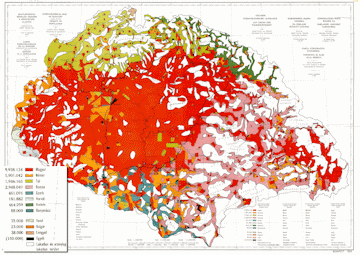
[download extra large image 4962x3509]
[download large image 1000x707]
Hungarian populations declined significantly after forced removals such as the Benes Decrees and other pograms, the effects of WWI, and Trianon in 1920. With continued pressure and discriminative policies such as the 2009 Slovak Language Law, this trend continued over the past 90 years.
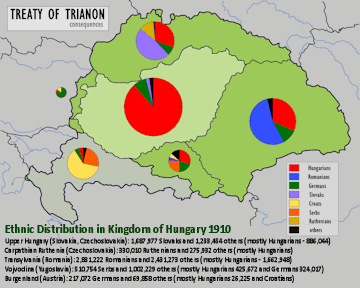
- In Upper Hungary (awarded to Slovakia, Czechoslovakia): 1,687,977 Slovaks and 1,233,454 others (mostly Hungarians - 886,044, Germans, Ruthenians and Roma) [according to the 1921 census, however, there were 1,941,942 Slovaks and 1,058,928 others]
- In Carpathian Ruthenia (awarded to Czechoslovakia): 330,010 Ruthenians and 275,932 others (mostly Hungarians, Germans, Romanians, and Slovaks)
- In Transylvania (awarded to Romania): 2,831,222 Romanians (53.8%) and 2,431,273 others (mostly Hungarians - 1,662,948 (31.6%) and Germans - 563,087 (10.7%)). The 1919 and 1920 Transylvanian censuses indicate a greater percentage of Romanians (57.1%/57.3%) and a smaller Hungarian minority (26.5%/25.5%)
- In Vojvodina 510,754 Serbs and 1,002,229 others (mostly Hungarians 425,672 and Germans 324,017)
- In Vojvodina and Croatia-Slavonia combined (awarded to Yugoslavia): 2,756,000 Croats and Serbs and 1,366,000 others (mostly Hungarians and Germans)
- In Burgenland (awarded to Austria): 217,072 Germans and 69,858 others (mainly Croatian and Hungarian)
[read more on the Treaty of Trianon]
AHF Related Links
External
Links
Read additional
Stories in HUNGARIAN
- 10/14/2005 - Koszorús Ferencet
idézi az újvidéki Magyar Szó: „NEMZETKÖZIESÍTSÜNK”-E
VAGY SEM: Tojástánc [tovább]
- 6/10/2005 - A MAGYAROK CSAK TÁNCOLJANAK:
Egybehangolt lejáratási kampány a VMSZ ellen [tovább]

These are .PDF files.
If you do not have the free
Adobe Reader, get it by clicking the icon

-
"Magyarellenes
Falfirkák Szabadkán,"
MAGYAR SZÓ, Novi Sad/Újvidék (in Hungarian) 4/3/2004
-
"Temetőgyalázás,"
MAGYAR SZÓ, Novi Sad/Újvidék (in Hungarian)
3/29/2004
- See the International
Crisis Group Report on Serbia from July 1994: Serbia's Changing
Political Landscape, a Briefing. An excerpt regarding Serb violence:
"Some Serbs in Vojvodina are demonstrating behaviour reminiscent
of that which they so frequently and vociferouslt condemn the Kosovo
Albanians."

 Monica
Seles - (b. in the Vajdaság (Vojvodina), the Hungarian region awarded to Serbia/Yugoslavia.) Monica
Seles - (b. in the Vajdaság (Vojvodina), the Hungarian region awarded to Serbia/Yugoslavia.)
Tennis Superstar - She has won 9 Grand Slam
singles titles and bronze in Sydney 2000!
Seles
(pronounced sell-esh and spelled Szeles Monika) won the European junior
championship at the age of ten. Born to a Hungarian family in the former
Hungarian province of Vojvodina, she moved to the United States in 1986,
and in 1989 turned professional. In 1990 she won her first French Open,
and in each of the following two years she won the Australian, United
States, and French opens. Seles won the Australian Open in early 1993,
but later that year, while resting between sets during a tournament in
Hamburg, Germany, she was stabbed by a spectator. The incident caused
Seles to withdraw from competition in 1993 and 1994. Seles returned to
competition in 1995 and won the initial tournament of her comeback, the
Canadian Open. In 1996 she again won the Australian Open.
Monica
is a fierce competitor and is still going strong into the new millennium
including winning the Bronze medal at the 2000 Sydney Olmpics!
See a small bio: http://www.bartleby.com/65/se/SelesMoni.html
AHF Statements on Trianon:
AHF Articles on Rumania:
 You will need the free Adobe Reader to open the following files. Click the image to download. You will need the free Adobe Reader to open the following files. Click the image to download.
Articles and Essays by AHF Members
- "NATO Enlargement" by Frank Koszorus Jr. March 29, 2004
Remarks on the Occasion of the Enlargement of NATO, Corcoran Gallery of Art, Washington, D.C. [download]
---
- "Nato Enlargement And Minority Rights: Prerequisites To Security" by Frank Koszorus, Jr., April 2003
A memorandum that was submitted to Robert A. Bradtke, Deputy Assistant Secretary for European and Eurasian Affairs, and Heather A. Conley, Deputy Assistant Secretary for European and Eurasian Affairs during a roundtable discussion on "NATO Enlargement and the Current State of the Trans-Atlantic Alliance." This submission follows several other intiatives, including submissions to Lord Roberston, Secretary General of NATO. [download]
---
- “Nato Enlargement: Promoting Western Values, Strengthening The Alliance” by Frank Koszorus, Jr., April 29, 2003
A Statement Before The United States Senate Committee On Foreign Relations.
[download]
---
- "U.S. Senate Unanimously Ratifies Nato Treaty; Senators Raise Rights Of Minorities: Federation Supports Efforts Aimed At Encouraging Romania And Slovakia To Respect Rights Of Hungarian Minorities And Restore Communal Properties" - Press Release by Zoltan Bagdy, May 9, 2003 [download]
Congressional Resolutions and Records
- H.RES 191 - A RESOLUTION urging the "prompt and fair restitution of church properties by Romania and Slovakia - TOM LANTOS / TOM TANCREDO (April 6th 2005) in the House of Representatives [download]
- A RESOLUTION REGARDING THE ISSUE OF TRANSYLVANIAN HUNGARIANS -- HON. DONALD E. `BUZ' LUKENS (Extension of Remarks - February 26, 1990) in the House of Representatives [download]
- VIOLENCE IN TRANSYLVANIA -- HON. DON RITTER (Extension of Remarks - March 22, 1990) in the House of Representatives [download]
- Transylvanian Monitor #14: Property Restitution.
Join online!

|



